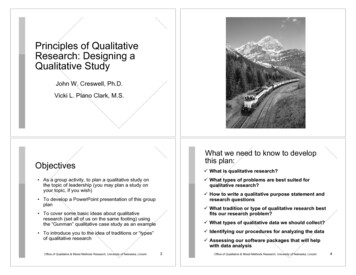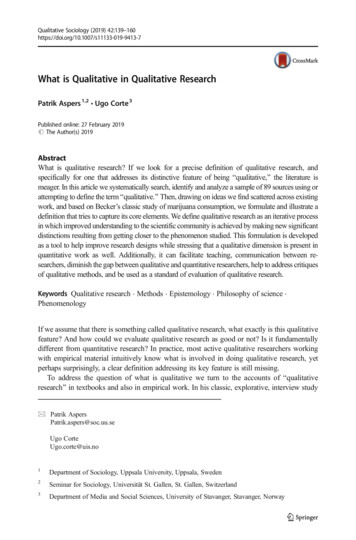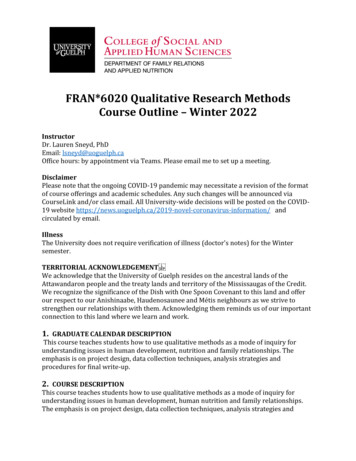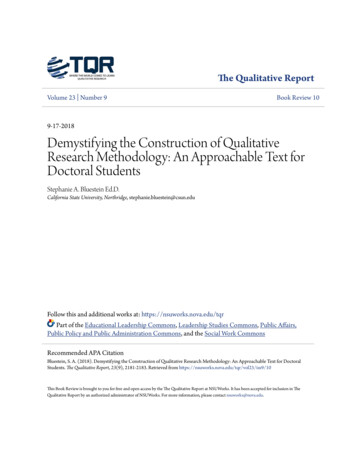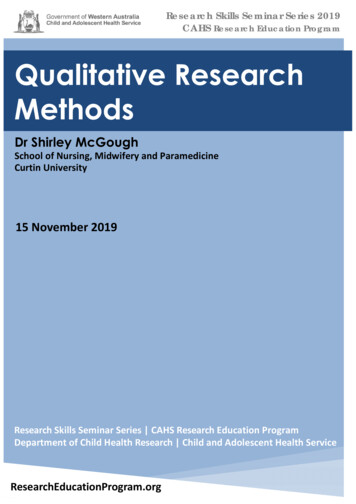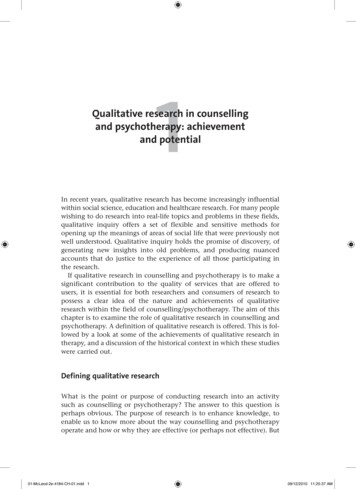
Transcription
Qualitative Research Methods inSocial Science: The Case StudyMethodNavaneeta RathDepartment of Sociology,Utkal University
What is qualitativeresearch? Qualitative research uses in-depth studies ofsmall groups of people to identify the issues,their stemming points, and the needs of thetarget group and the intricacies of the problem. It becomes more penetrating in character. The results of qualitative research are descriptive. Qualitative research unfolds the intricacies ofhuman behaviour and action in heterogeneoussettings.
Methods of qualitative researchThe qualitative research techniques that can be putinto use in social science research include, Direct Observation throughparticipation, Case study Documenting oral history Narratives FGDs Phenomenology Grounded theory
Case Study: Defining the Method Case study is a robust research methodencompassing a holistic, in-depth investigation.Robert K. Yin defines the case studyresearch method as an empirical inquirythat investigates a contemporaryphenomenon within itsreal-life context; when the boundariesbetween phenomenon and context are notclearly evident. (Yin, 1984, p. 23).
Proponents of Case StudyMethod: Charles Ragin and Howard S. Becker (1992) definecase study as detailed and often subtleunderstandings of the social organization ofeveryday life and persons’ experiences Well known case study researchers are Robert E. Stake Helen Simons Robert K. Yin
Characteristics of Case Study Method: Heuristic: illuminates the researcher’sunderstanding beyond original knowledge Particularistic Descriptive Extensive in terms of time Intensive in terms of stuff Natural Environment Involves direct observation, interviews, insightinto the deeper root
Where to Use? Immersion of the researcher in the lives andconcerns of the persons, communities, ororganizations they study Minority groups are best addressed. Difficult cases are best handled throughcase study method Egs: Prisoners, AIDS Victims, Girls suffering fromsexual abuse, Protestants, Delinquents, Criminals,Depression, Mental health patients
Famous Studies Using Case studyMethod in Social Science Hughes’s study, which is subtitled TheAutobiography of a Drug Addict, details the lifeexperiences of Janet Clark, a young white womanliving in a poor urban area. Robert E. Park (1916) used it to study ethnicminorities. William Whyte’s (1943) of Chicago school used casestudy for Street Corner Society studies. Erving Goffman (1959), used case studies todevelop a dramaturgical perspective on socialinteraction.
Recent Instances of Famous CaseStudies Ruth Horowitz’s (1983) case study of a Hispaniccommunity. Elijah Anderson’s (1990) research in an AfricanAmerican community. Jaber Gubrium’s (1993) analysis of the life storiestold to him by a group of elderly nursing homeresidents. Sarah Thornton’s (1996) case study of dance clubsand raves in London.
Types of Case study Method Yin (1984) explains three types as exploratory, descriptiveand explanatory case studies. Exploratory case studies set to explore any phenomenon inthe data which serves as a point of interest to the researcher.A pilot study is considered an example of an exploratory casestudy. Descriptive case studies may be in a narrative form. Anexample of a descriptive case study is the journalisticdescription. Explanatory case studies are deployed for causal studiesphenomena in very complex and multivariate cases.
Continued: McDonough and McDonough (1997) describesanother two types of case study. They are:Interpretive and Evaluative case studies The researcher aims to interpret the data bydeveloping conceptual categories, supporting orchallenging the assumptions made regardingthem. In evaluative case studies, the researcher goesfurther by adding their judgement to thephenomena found in the data.
Stages in Case Study 6 “I”sIdentification of the caseInterrogation about the contextInformation compilationIllustration documentationsInterpretation of the information revealedInference Drawing
Process of Conducting Reaching out the CaseSettingRapport buildingInformalitySpontaneityDevotion of time and space and patienceRecordingTranscription
Two types of describing data Case Story: Added to quantitative technique Case Report: For fully qualitative study
Case Report An introduction to the case under study Rapport building to ease the environment Interrogation to the case Perception, opinion and Interpretation of the versions Inferences drawn Concluding comments
Pros and Cons of Case StudyProsConsNavigation into difficult cases where manythings remain hiddenTime consuming and needing immense patienceHow and whys are easily delved out. It helpsin developing critical and reflective thinking,problem solving, decision making among thenursing professionals.Hard to draw definite cause-effect conclusionsProvides better insight into the case makingtreatment easier.Hard to generalize from a single casePossible biases in data collection andinterpretation (since single person gathers andanalyzes the information)
Five misunderstandings about casestudy method General, theoretical (context-independent) knowledge is morevaluable than concrete, practical (context-dependent) knowledge.One cannot generalize on the basis of an individual case;therefore, the case study cannot contribute to scientificdevelopment.The case study is most useful for generating hypotheses; that is, inthe first stage of a total research process, while other methods aremore suitable for hypotheses testing and theory building.The case study contains a bias toward verification, that is, atendency to confirm the researcher’s preconceived notions.It is often difficult to summarize and develop general propositionsand theories on the basis of specific case studies.
What is qualitative research? Qualitative research uses in-depth studies of small groups of people to identify the issues, their stemming points, and the needs of the target group and the intricacies of the problem. It becomes more penetrating in character. The results of qualitative research are descriptive.
